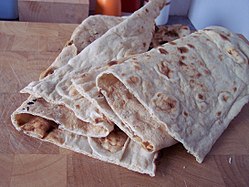 Balep korkun, with veg soup. | |
| Alternative names | Tsampa Balep, Tibetan Flatbread |
|---|---|
| Type | Flatbread |
| Place of origin | Tibet |
| Region or state | Amdo, Kham, U-Tsang |
| Main ingredients | Tsampa, water, baking powder |
Balep korkun or Yosang balep is a type of bread that is consumed mainly in central Tibet. [1] [2] It is round, flat and relatively easy to make. [2] The ingredients are tsampa (barley flour), water and baking powder. [2] It is cooked in a frying pan. [2] It has been described as similar in appearance to naan. [3]

